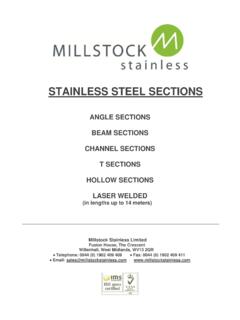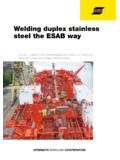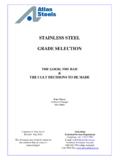Transcription of STAINLESS STEEL LEAN DUPLEX SECTIONS
1 STAINLESS STEELLEAN DUPLEXSECTIONSANGLE SECTIONSBEAM SECTIONSCHANNEL SECTIONST SECTIONSHOLLOW SECTIONSLASER WELDED(in lengths up to 14meters)Millstock STAINLESS LimitedFusionHouse, The CrescentWillenhall, West Midlands, WV13 2QR Telephone: 0044 (0) 1902 409 409 Fax:0044 (0) 1902 409 411 Email: DuplexHigh performance laser fused Structural SectionsIntroduction STAINLESS steels are used predominantly for their corrosion resistance in moderate to highly aggressive environments. For construction purposes, carbon STEEL normally is the common choice due to low cost, long experience, applicable design rules and a large variety of strength classes. However, different STAINLESS STEEL types can also provide a very wide range of mechanical properties and they have the advantage of no need for surface protection.
2 DUPLEX STAINLESS steels in particular, with twice the mechanical strength of conventional austenitic and ferritic STAINLESS steels, have a potential for use in constructions. Since the introduction of this family of steels about seventy years ago, they have been widely used. lean DUPLEX STAINLESS Steels (LDSS) are a subset of the DUPLEX family that has seen significant growth and development over the last years. The drivers for this development have been soaring raw material costs along with increasing demand for improved corrosion resistance and strength. Today there are four different LDSS grades available on the market and new ones are being have been used or are being considered as substitutes for STAINLESS STEEL types and in various applications.
3 Some examples of industry end uses are structural supports for the onshore and offshore oil & gas industry, architectural & building, desalination equipment, wastewater treatment facilities, pulp & paper, chemical processing, automotive & transportation, etc. The list keeps growing as more industries become aware of the advantages of LDSS. Corrosion aspectsLDSS' resistance to localized corrosion, such as pitting and crevice attack, is similar to type or A numerical relationship between pitting resistance and alloying content has been developed to compare the four LDSS to common austenic STAINLESS steels ( ). This numerical relationship is known as pitting resistance equivalent number or PREN (PREN = Cr + x %Mo + 16 x %N).
4 Chemical analysisPRENENType ,071,02,00,0450,03017,0-19,58,0-10,5--- 0, ,031,02,00,0450,03016,5-18,510,0-13,02,0 -2,5 0,1124-20010,031,04,0-6,00,0400,03019,5- 21,51,0-3,00,1-0,60,05-0, ,041,04,0-6,00,0400,03021,0-22,01,35-1,7 0,1-0,80,20-0, ,031,02,00,0350,01522,0-24,03,5-5,50,1-0 ,60,05-0,2026-20030,031,02,00,0300,02019 ,5-22,53,0-4,01,5-2,00,14-0, ,031,02,00,0350,01521,0-23,04,5-6,52,5-3 ,50,10-0,2235 LDSS are leaner alloys than the standard type DUPLEX STAINLESS STEEL and cannot equal its corrosion resistance, especially in high chloride environments, but they have a much better resistance than and in most cases perform as well as, or better then As a result, LDSS are suitable for use in a wide range of applications and DuplexHigh performance laser fused Structural Pitting and crevice corrosion resistanceNote: Type 2001 is proprietary of AK STEEL (Nitronic 19D) Type 2101 is proprietary of Outokumpo (LDX 2101 ) Type 2003 is proprietary of Allegheny Ludlum (AL 2003 ) Laser fusion of structural SECTIONS in LDSS Laser fusion of lean DUPLEX does not differ substantially from the process used for austenitic STAINLESS STEEL grades.
5 While the process parameters vary only slightly, the big difference lies in the microstructure that results from the ultra-rapid cooling of the weld grades roughly have a 50% austenitic and 50% ferritic microstructure. The alloying elements are balanced in order to achieve this distribution after a classical solution annealing treatment. There is a certain variance in the distribution and up to a 65:35 ratio in favour of one or the other of the two microstructures is considered laser welding the base material melts and then solidifies extremely rapidly. The cooling speed normally is in excess of 500 C/s, which means that the segregations found with classical welding methods are totally avoided when using laser welding.
6 On the other hand, this same rapid cooling rate causes a preference for the ferritic microstructure. Corrosion resistance of structural SECTIONS in LDSSIn an as welded condition the corrosion resistance of the weld and heat affected zone of a LDSS structural section produced by laser fusion still is equivalent or better than STAINLESS STEEL type By solution annealing or using a laser-hybrid welding system the classical balanced DUPLEX microstructure can be reinstated. The optional solution annealing or laser-hybrid welding of LDSS should only be considered in cases where high mechanical strength and superior corrosion protection is 2 lean DUPLEX beamFig. 3 Crash test2 Laser fused structural SECTIONS have a monolithic structure with a controlled area of heat input and a small, barely noticeable seam at the juncture of the components.
7 Extensive destructive testing has shown that the fracture points in laser fused SECTIONS rarely lie in the weld area stresses and loads applied to the SECTIONS are transmitted to the neighbouring parent material which then fails according to its own mechanical characteristics (Fig. 3).The mechanical characteristics of the weld and heat affected zone of structural SECTIONS in LDSS are no constraint in industrial properties of structural SECTIONS in LDSSLean DuplexHigh performance laser fused Structural SectionsFig. 8 SINGLE SPAN LOAD - Comparison of beam sizesFig. 9 SINGLE SPAN LOAD - Material savingFig. 10 TENSION TIE - Material saving* same properties as IPE 300 due to better mechanical values* same properties as IPE 300 due to better mechanical valuesThe following chart (Fig.)
8 8) clearly shows the advantages of higher yield properties in structural SECTIONS based on single span performance. a IPE 220 in achieves the same structural performance of an IPE 330 in standard austenitic STAINLESS STEEL . In other terms, under the same span load the material saving potential of is 38% compared to austenitic STAINLESS STEEL beams on a bar length of 5 m (Fig. 9). When comparing the tension tie of with type or the material saving goes up to 48% by using lighter section with the same structural performance (Fig. 10).5 lean DuplexHigh performance laser fused Structural SECTIONS









